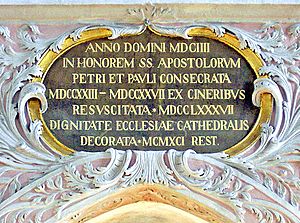Anno Domini facts for kids
Anno Domini is a Latin phrase meaning "In the year of (our) Lord." It is often shortened to AD or A.D.. This system is used to count the years after the birth of Jesus. Sometimes, AD is also called the Christian Era.
The term Before Christ, shortened as BC or B.C., is used for all the years before the AD period began. When you write a year, AD usually comes before the number (like AD 70). However, BC always comes after the number (like 70 BC).
In this system, AD 1 comes right after 1 BC. There is no year zero between them. This way of counting years was created to mark the birth of Jesus. However, modern studies suggest Jesus was actually born a few years earlier than AD 1.
How Our Calendar Years Began
The system we use to number years was created by a person named Dionysius Exiguus. He was a monk who lived around AD 525. He set the starting point for Anno Domini. This point is used in both the Gregorian calendar and the Julian calendar.
Dionysius created this system to help organize his Easter table. This table helped people figure out when Easter would happen each year. He did not use it to date historical events at first. When he made his table, years were usually named after the consuls who were in charge that year.
Dionysius said that his "present year" was 525 years "since the incarnation [conception] of our Lord Jesus Christ." We don't know exactly how he figured out this number. He wanted to replace an older system that used "Diocletian years." He disliked this old system because it honored a ruler who had treated Christians badly.
The Anno Domini system became very popular in Western Europe. This happened after a famous historian named the Venerable Bede used it. He used it to date events in his book, Ecclesiastical History of the English People, which he finished in 731. Later, the French emperor Charlemagne helped make it even more widely used across Europe. Some parts of Europe did not start using the Anno Domini system until the 15th century. For example, Portugal used a different system called the Spanish era until 1422.
Images for kids
-
A statue of Charlemagne by Agostino Cornacchini (1725), at St. Peter's Basilica, Vatican City. Charlemagne helped spread the use of the Anno Domini system across his empire.
See also
 In Spanish: Anno Domini para niños
In Spanish: Anno Domini para niños



